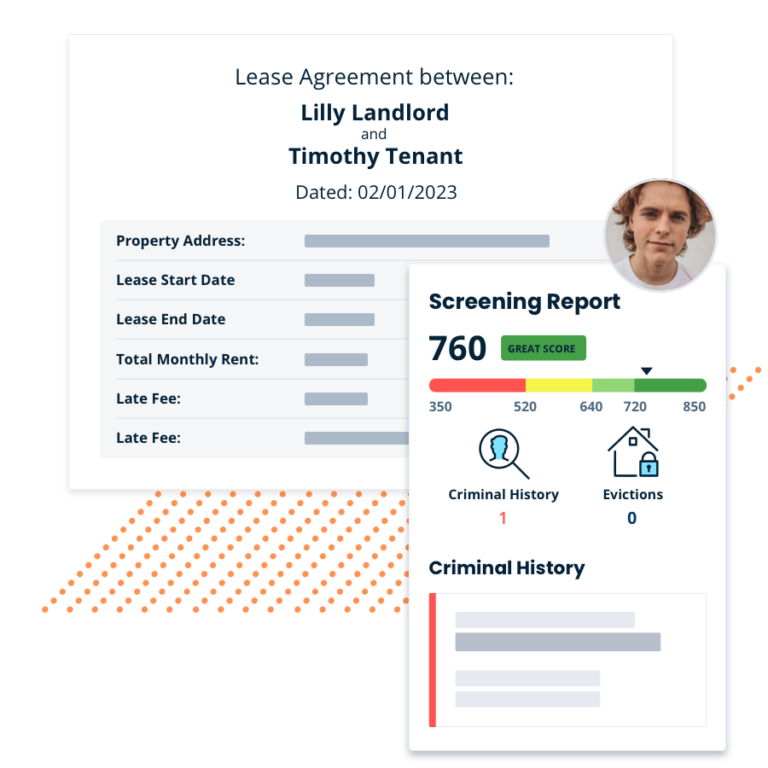As a landlord, you want to make sure your rental property is being taken care of by your tenants. Most importantly, you want to make sure that your real estate investment is secure.
A lease agreement template is an essential tool for making sure all parties have an understanding of their responsibilities and rights. It’s not enough to just read over the lease agreement and hope everything is clear and there are no surprises down the road.
That’s why we’ve put together this handy guide on all things regarding lease agreement templates; what they are, who uses them, how they work, and what they should say.

Table of Contents
What Is a Rental Lease Agreement?
A rental lease agreement is a legal document that defines the terms and conditions of renting out a property. It’s an agreement between landlords and tenants that ensures they’re on the same page about every aspect of their arrangement.
It’s important to have a rental agreement in place before you start renting out to tenants, as it ensures that both parties know exactly what they’re getting into and helps avoid any confusion or disputes down the line.
Who Needs a Lease Agreement?
If you’re renting out your property, you need to have a lease agreement. A lease agreement is a contract between the landlord and tenant that protects both parties in the event there is a dispute over any aspect of their rental agreement.
Important Parts of a Standard Residential Lease Agreement
There are several essential elements to a standard residential lease agreement, to ensure that everyone signing it is properly covered in case anything goes awry. We’re going to break down the most important parts for you, so you can better understand what’s in your lease and know what to look for when you’re signing one.
Use the following crucial inclusions as a tenant lease agreement template to build your own custom lease.
Template of a Lease Agreement for a Tenant

1. Security Deposit
A security deposit is a fee the tenant pays the landlord or property manager at the beginning of the term of the lease. The security deposit covers any potential damages or unpaid rent that may occur. The landlord holds this money until the end of the rental term, at which they return it to the tenant if no damages or other fees are owed. Typically, landlords require that tenants pay one month’s rent as a security deposit.
2. Monthly Rent Amount
This is how much money you charge each month for living in your rental properties. Depending on your rental agreement, it may include utilities such as electricity and water usage costs. The tenant is obliged to pay the amount every month for their rent.
3. Background Check
A background check ensures that potential renters are who they say they are and that there aren’t any red flags on their record that would make them dangerous or unreliable tenants for your property.
Landlords typically require background checks on prospective tenants‘ criminal history or rental history before letting them move in. This section would be where you’d include information about those checks so potential tenants can review them in advance.
4. Late Rent
If tenants don’t pay their rent on time or by the due date, they can be subject to penalties and late fees (depending on how late they are). This section should clearly state what happens when rent is not paid on time, including how long of a grace period they’re allowed.
5. Period of Time
This section will specify the amount of time or duration that the lease will last (i.e., one year or month-to-month). It specifies how long it takes for the lease to expire and whether or not there are any renewal options available at the end of the lease term.
If there aren’t any renewal options, this section may also include information about what happens if one party terminates early or if both parties mutually agree to terminate early.
6. Smoking Policy
Many leases require tenants to abide by a no smoking policy. Occasionally, landlords will make exceptions for medical marijuana users or smokers who want to smoke in their homes but not in public spaces like hallways.
Generally, this section specifies whether smoking is allowed on premises or not (and if so, where).
7. Pet Policy
Similar to the smoking policy, the pet policy for a rental is important to explicitly define in the rental agreement. According to the American Pet Products Association, 70% of American homes have pets, and when a landlord chooses to allow pets they can also collect pet deposits and monthly pet rental fees.
This section allows a property manager to define how many pets they allow (if any), what breeds or species, and how they’ll deal with any resulting property damage caused by the pet.
8. Paint Disclosure
Almost every lease agreement will have a section covering paint disclosures or the landlord’s responsibility to disclose any damage to the property before signing the lease. This ensures that both parties are aware of any damage and can account for it in the rental price or remediate it before moving in.
If the property was built before 1978, it may contain lead-based paint, which can cause health problems in young children or pregnant women. By law, knowledge of lead-based paint in the rental must be disclosed in this section. If there are stains on the walls or water damage discoloration, this will also be mentioned
9. Subletting
Subletting is when the tenant leases your property to another person during the lease period. This section lets you specify whether or not you will allow your tenant to sublet their apartment during their lease period and, if so, under what conditions.
10. Evictions
Evictions are another thing that should be included in your lease agreement to state what kind of behavior would warrant eviction proceedings or would be enough grounds for requesting tenants to vacate your rental property.
When a renter repeatedly doesn’t pay rent on time or breaks any other rules outlined in the lease agreement (such as the smoking policy or pet policy), then this section will come into play to state why and how to move out tenants. You will have to give tenants a 7-, 14-, or 30-day notice using a formally written notice (typically an eviction notice) before they must vacate.

Lease Agreements by State
Lease agreements can differ by state, which is why we’ve created a guide to help you find the right lease agreement template for your needs.
For example, the laws governing rental property in New York differ from those in California, Texas, or Florida. If you’re planning on renting a property in New York, you’ll need to be familiar with the state laws governing tenancy in that area.
While lease agreements everywhere share many similarities, you should know about some key differences unique to your state.
Lease Agreements by Type
When you’re looking for a lease agreement template, you want to make sure that it will work for your needs and your tenant’s needs. Here are some of the most common lease types:
- Residential lease agreement: A residential lease agreement is a rental contract between a landlord and a tenant in which the landlord agrees to rent out their residential property to the tenant. This type of lease agreement is used when a person rents out their home, condominium, or apartment. Every rental arrangement should include its own lease agreement.
- Commercial lease agreement: A commercial lease agreement is a contract between a lessee/landlord and a lessor/tenant in which the lessor agrees to rent out their property for commercial use by the lessee. This lease agreement is used when renting out office space, industrial units, warehouse space, retail rental units, or any other commercial property.
- Sublease agreement: This is where one person rents their property to another party (the sublessee) and then transfers a portion of their rights under the terms of the agreement to them.
- Fixed-term lease: The tenant pays rent for a fixed period (typically 12 months, but a short-term lease could be six months or fewer) and then moves out at the end of the term to make way for a new tenant.
- Month lease agreement: A month rental agreement is a popular type of lease agreement because it offers tenants more flexibility than a fixed-term lease. This would be a month-to-month lease, renewed monthly for as long as both parties see fit.
- Open-ended lease: An open-ended lease has no specific number of days; instead, it simply states that one party intends to occupy the premises indefinitely or until one party decides to terminate.
Lease Agreement Addendums
In most cases, the signed lease agreement will be complete and ready for use. However, there are times when you may want to make changes or additions to the existing document. This can be done through the use of a lease addendum.
An addendum is something that is added to an existing agreement after it has already been signed. It may not change or alter any part of the original contract, but it will offer additional information that might be useful for both parties. For example, if there’s an issue with parking or storage space, or a pet policy needs further clarification, then this could be addressed in an addendum.
Lease Agreement vs. Rental Agreement
The terms “lease agreement” and “rental agreement” are often used interchangeably, but they’re not actually the same thing. A lease agreement is a legally binding contract between a landlord and tenant that outlines all the terms of their rental relationship.
A rental agreement is often just part of a lease agreement but can also refer to an informal rental commitment between landlords and tenants that isn’t legally binding.
There are two main differences between these two types of agreements: lease agreements are more comprehensive than rental agreements, and lease agreements are legally binding while rental agreements aren’t.
What Happens If You Don't Have a Lease Agreement?
Well, the short answer is that it depends on what state you live in. In some states like New York and California, according to the landlord-tenant laws, you need to have a contract in writing before you can ask for rent payments or collect any other money from your tenant. In other states, it’s not required but is recommended because it protects both parties from disputes later down the road.
In any case, having a written lease agreement between a landlord and tenant will help clarify expectations from both sides and provide recourse should either party decide to terminate or break their agreement. So, while it’s possible to rent out your home without having a formal lease agreement in place, it’s not a great idea and we always recommend having one.
Get Your Tenant Lease Agreement Template Today!
Now that you’re fully equipped with everything you need to know about lease agreements, it’s time to consider signing up for TurboTenant and using our state-specific lease agreements. We offer customizable and simple state-specific leases built to fit your specific needs.







